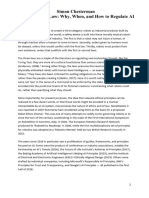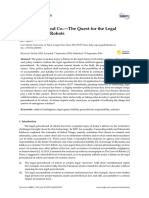Conclusion
Conclusion
Uploaded by
kamal01236Copyright:
Available Formats
Conclusion
Conclusion
Uploaded by
kamal01236Copyright
Available Formats
Share this document
Did you find this document useful?
Is this content inappropriate?
Copyright:
Available Formats
Conclusion
Conclusion
Uploaded by
kamal01236Copyright:
Available Formats
Conclusion
If a military robot refuses an order, e.g., if it has better situational awareness, then who would be responsible for its subsequent actions? How stringent should we take the generally-accepted eyes on target requirement, i.e., under what circumstances might we allow robots to make attack decisions on their own? What precautions ought to be taken to prevent robots from running amok or turning against our own side, whether through malfunction, programming error, or capture and hacking? To the extent that military robots can help reduce instances of war crimes, what is the harm that may arise if the robots also unintentionally erode squad cohesion given their role as an outside observer? Should robots be programmed to defend themselvescontrary to Arkins positiongiven that they represent costly assets? Would using robots be counterproductive to winning the hearts and minds of occupied populations or result in more desperate terrorist-tactics given an increasing asymmetry in warfare?
1. Creating autonomous military robots that can act at least as ethically as human soldiers appears to be a sensible goal, at least for the foreseeable future and in contrast to a greater demand of a perfectly-ethical robot. However, there are still daunting challenges in meeting even this relativelylow standard, such as the key difficulty of programming a robot to reliably distinguish enemy combatants from non-combatants, as required by the Laws of War and most Rules of Engagement.
2. While a faster introduction of robots in military affairs may save more lives of human soldiers and reduce war crimes committed, we must be careful to not unduly rush the process. Much different than rushing technology products to commercial markets, design and programming bugs in military robotics would likely have serious, fatal consequences. Therefore, a rigorous testing phase of robots is critical, as well as a thorough studies of related policy issues, e.g., how the US Federal Aviation Administration (FAA) handles UAVs flying in our domestic National Airspace System (which we have not addressed here).
3. Understandably, much ongoing work in military robotics is likely shrouded in secrecy; but a balance between national security and public disclosure needs to be maintained in order to help accurately anticipate and address issues of risk or other societal concerns. For instance, there is little information on US military plans to deploy robots in space, yet this seems to be a highly strategic area in which robots can lend tremendous value; however, there are important environmental and political sensitivities that would surround such a program.
4. Serious conceptual challenges exist with the two primary programming approaches today: topdown (e.g., rule-following) and bottom-up (e.g., machine learning). Thus a hybrid approach should be considered in creating a behavioural framework. To this end, we need to a clear understanding of what a warrior code of ethics might entail, if we take a virtue-ethics approach in programming.
5. In the meantime, as we wait for technology to sufficiently advance in order to create a workable behavioural framework, it may be an acceptable proxy to program robots to comply with the Laws of War and appropriate Rules of Engagement. However, this too is much easier said than done, and at least the technical challenge of proper discrimination would persist and require resolution.
6. Given technical limitations, such as programming a robot with the ability to sufficiently discriminate against valid and invalid targets, we expect that accidents will continue to occur, which raise the question of legal responsibility. More work needs to be done to clarify the chain of responsibility in both military and civilian contexts. Product liability laws are informative but untested as they relate to robotics with any significant degree of autonomy.
7. Assessing technological risks, whether through the basic framework we offer in section 6 or some other framework depends on identifying potential issues in risk and ethics. These issues vary from: foundational questions of whether autonomous robotics can be legally and morally deployed in the first place, to theoretical questions about adopting precautionary approaches, to forward-looking questions about giving rights to truly autonomous robots. These discussions need to be more fully developed and expanded.
8.
Specifically, the challenge of creating a robot that can properly discriminate among targets is one of the most urgent, particularly if one believes that the (increased) deployment of war robots is inevitable. While this is a technical challenge and resolvable depending on advances in programming and AI, there are some workaround policy solutions that can be anticipated and further explored, such as: limiting deployment of lethal robots to only inside a kill box; or designing a robot to target only other machines or weapons; or not giving robots a self-defence mechanism so that they may act more conservatively to prevent; or even creating robots with only non-lethal or less-than-lethal strike capabilities, at least initially until they are proven to be reliable.
You might also like
- International Relations and The Study of History - Oxford Research EncyclopediasDocument18 pagesInternational Relations and The Study of History - Oxford Research EncyclopediasM BerlinNo ratings yet
- Frank Pasquale - New Laws of Robotics - Defending Human Expertise in The Age of AI-Belknap Press (2020)Document341 pagesFrank Pasquale - New Laws of Robotics - Defending Human Expertise in The Age of AI-Belknap Press (2020)LeahNo ratings yet
- Lapsus Imaginis The Image in Ruins Eduardo CadavaDocument27 pagesLapsus Imaginis The Image in Ruins Eduardo CadavaMadalena MachadoNo ratings yet
- Guide To The Analysis of InsurgencyDocument40 pagesGuide To The Analysis of InsurgencyNikolaT100% (1)
- Introduction To International Conflict ManagementDocument34 pagesIntroduction To International Conflict ManagementkimenderoNo ratings yet
- Taming The Killer Robot Toward A Set ofDocument31 pagesTaming The Killer Robot Toward A Set ofprof William S. DantasNo ratings yet
- Ethical Robots in Warfare: Ronald C. ArkinDocument4 pagesEthical Robots in Warfare: Ronald C. ArkinJeff JerousekNo ratings yet
- AI HUMANDocument18 pagesAI HUMANtumul.purwarNo ratings yet
- Lethal Autonomous Weapons (Paper For ENGR 392)Document6 pagesLethal Autonomous Weapons (Paper For ENGR 392)lipiamin1234No ratings yet
- Deadly Algorithms: Can Legal Codes Hold Software Accountable For Code That Kills?Document7 pagesDeadly Algorithms: Can Legal Codes Hold Software Accountable For Code That Kills?Susan SchuppliNo ratings yet
- Robotics and Military Operations - BattistaDocument9 pagesRobotics and Military Operations - BattistaamaterasublazingNo ratings yet
- Difficulty of Programming Robotics For EthicsDocument1 pageDifficulty of Programming Robotics For EthicsVidya DhamodharNo ratings yet
- Artificial Intelligence in The Defense Sector A Boon or A BaneDocument3 pagesArtificial Intelligence in The Defense Sector A Boon or A BanemarketingNo ratings yet
- Grounds For Discrimination: Autonomous Robot WeaponsDocument4 pagesGrounds For Discrimination: Autonomous Robot Weapons404 System ErrorNo ratings yet
- Mil Technology Latest TrendDocument37 pagesMil Technology Latest Trendprajwal khanalNo ratings yet
- 0457 02 Id167 0029 IrDocument6 pages0457 02 Id167 0029 IrFuazXNo ratings yet
- Robotics-2Document7 pagesRobotics-2hanif38233No ratings yet
- The Legal Liability For Autonomous RoboticsDocument30 pagesThe Legal Liability For Autonomous RoboticsDr.Safaa Fetouh GomaaNo ratings yet
- Why Nonprofit and Nongovernmental?Document3 pagesWhy Nonprofit and Nongovernmental?Mariami GoshkhetelianiNo ratings yet
- The Future of WarsDocument28 pagesThe Future of WarsRachelLyeNo ratings yet
- Tim Bradley AS2Document10 pagesTim Bradley AS2TimBradleyNo ratings yet
- Law and Ethics For Autonomous Weapon SystemsDocument32 pagesLaw and Ethics For Autonomous Weapon SystemsHoover Institution100% (3)
- Chesterman Simon Ethics To LawDocument14 pagesChesterman Simon Ethics To LawKami MiklaiNo ratings yet
- The Quest For The Legal Personhood of RobotsDocument11 pagesThe Quest For The Legal Personhood of RobotsGustavo Pereira SilvaNo ratings yet
- The Unmanned WarfareDocument19 pagesThe Unmanned WarfareSharon D'SouzaNo ratings yet
- International Governance of Autonomous Military RobotsDocument45 pagesInternational Governance of Autonomous Military RobotsPaulinah SyumbuaNo ratings yet
- Artificial Intelligence in Military Operations: Technology, Ethics and The Indian PerspectiveDocument4 pagesArtificial Intelligence in Military Operations: Technology, Ethics and The Indian PerspectiveLt Gen (Dr) R S PanwarNo ratings yet
- Future Risks of Frontier Ai Annex ADocument44 pagesFuture Risks of Frontier Ai Annex Aminh đứcNo ratings yet
- Celeste ExamDocument4 pagesCeleste Examf.celeste91No ratings yet
- Kostenko Anna Pactice 08.04.2022Document2 pagesKostenko Anna Pactice 08.04.2022Anna KostenkoNo ratings yet
- Ai Notes Unit-VDocument25 pagesAi Notes Unit-Vjosphineleela ramakrishnanNo ratings yet
- Safety Considerations of Humanoid RobotsDocument8 pagesSafety Considerations of Humanoid RobotsSmritiNo ratings yet
- Inquiry EssayDocument7 pagesInquiry Essayapi-248878413No ratings yet
- Lethal Autonomous Weapons SystemsDocument7 pagesLethal Autonomous Weapons SystemsDorjee SengeNo ratings yet
- Historical and Contemporary Reflections On Lethal Autonomous Weapons SystemsDocument4 pagesHistorical and Contemporary Reflections On Lethal Autonomous Weapons SystemsveneziaasdfNo ratings yet
- Kott, Alexander, Ananthram Swami, and Bruce J. West. "The Internet of Battle Things."Document11 pagesKott, Alexander, Ananthram Swami, and Bruce J. West. "The Internet of Battle Things."vivgoNo ratings yet
- RWS Project Artificial Intelligence HADIDocument12 pagesRWS Project Artificial Intelligence HADIALI ABDUL HADINo ratings yet
- Henry W Grady-Nkosi-Wakefield-Neg-Greenhill RR-Round4Document48 pagesHenry W Grady-Nkosi-Wakefield-Neg-Greenhill RR-Round4IanNo ratings yet
- LAWS Negate-Dead Hand PIC and Spec TheoryDocument8 pagesLAWS Negate-Dead Hand PIC and Spec TheoryTrentonNo ratings yet
- Robot CriminalsDocument47 pagesRobot CriminalsAlexp91No ratings yet
- Rai Ethics of Ai in Warfare PDFDocument3 pagesRai Ethics of Ai in Warfare PDFssnayhtinNo ratings yet
- Criminal Liability of RobotsDocument7 pagesCriminal Liability of RobotsArshdeep Singh ChahalNo ratings yet
- CIGI Military AI PrinciplesDocument2 pagesCIGI Military AI PrinciplesjesseNo ratings yet
- KaminskiDocument65 pagesKaminskiakshataryansteamNo ratings yet
- Carter, A. (2022). the Moral Dimension of AI-Assisted Decision-making- Some Practical Perspectives From the Front Lines. Daedalus, 151(2), 299-308Document10 pagesCarter, A. (2022). the Moral Dimension of AI-Assisted Decision-making- Some Practical Perspectives From the Front Lines. Daedalus, 151(2), 299-308Africa GuevaraNo ratings yet
- Legal Rights and Legal Liabilities of RobotsDocument6 pagesLegal Rights and Legal Liabilities of RobotsSrujan NirkheeNo ratings yet
- Why Artificial Intelligence MattersDocument8 pagesWhy Artificial Intelligence Matterstahena.vidalNo ratings yet
- Impact of Artificial Intelligence On Legal Industry: Code No.: Sols27Document7 pagesImpact of Artificial Intelligence On Legal Industry: Code No.: Sols27annuNo ratings yet
- The Future of Military Applications of Artificial Intelligence: A Role For Confidence-Building Measures?Document16 pagesThe Future of Military Applications of Artificial Intelligence: A Role For Confidence-Building Measures?George KaragiannidisNo ratings yet
- Graduation Research Project Topic IdeasDocument5 pagesGraduation Research Project Topic Ideasarwa mezarNo ratings yet
- Thesis Topics in RoboticsDocument6 pagesThesis Topics in Roboticslizbundrenwestminster100% (3)
- Ai 2016 FormattedDocument14 pagesAi 2016 FormattedVy VyNo ratings yet
- Disruptive Military Technologies - An Overview - Part IDocument7 pagesDisruptive Military Technologies - An Overview - Part ILt Gen (Dr) R S PanwarNo ratings yet
- GYLS Sample 3Document7 pagesGYLS Sample 3sanjit75204No ratings yet
- Key Challenges Faced by Us Military: (I) Increase in Cyber-War FareDocument5 pagesKey Challenges Faced by Us Military: (I) Increase in Cyber-War FareGaurav SrivastavaNo ratings yet
- Ethics Example Essay 1Document13 pagesEthics Example Essay 1NNo ratings yet
- Detecting Environmental Crimes Using AI: A Technical Seminar Report ONDocument34 pagesDetecting Environmental Crimes Using AI: A Technical Seminar Report ONGanga KeerthiNo ratings yet
- Unit 4Document16 pagesUnit 4rythmjaggaNo ratings yet
- KjkjikjkiDocument2 pagesKjkjikjkiplavariba05No ratings yet
- HHRG 118 AS35 Wstate PattD 20240313Document10 pagesHHRG 118 AS35 Wstate PattD 20240313Zoran ConstantinescuNo ratings yet
- Military Budget Should Be IncreasedDocument18 pagesMilitary Budget Should Be IncreasedGoran ČalušićNo ratings yet
- 2017-02-26 - Lethal Autonomous Weapon Systems and The Conduct of HostilitiesDocument4 pages2017-02-26 - Lethal Autonomous Weapon Systems and The Conduct of HostilitiesgfournierNo ratings yet
- The Ethics of Using Robots in Combat - MeyerDocument17 pagesThe Ethics of Using Robots in Combat - MeyeramaterasublazingNo ratings yet
- History Causes of World War I: Grade 5 Social Studies OnlineDocument21 pagesHistory Causes of World War I: Grade 5 Social Studies Onlinejcookie92No ratings yet
- Armies of Greyhawk - Great Kingdom p1Document5 pagesArmies of Greyhawk - Great Kingdom p1Sebastian LeonNo ratings yet
- Param Vir Blog Abdul HamidDocument3 pagesParam Vir Blog Abdul HamidMohammed KhaliqNo ratings yet
- TC 7-100.2 Opfor Tactics Dec 2011Document446 pagesTC 7-100.2 Opfor Tactics Dec 2011Scott Grammer100% (4)
- CSAT - Reading Comprehension PDFDocument14 pagesCSAT - Reading Comprehension PDFAyush SharmaNo ratings yet
- Thayer China's Decade Long Hybrid War Against Vietnam, 1977-1987.Document19 pagesThayer China's Decade Long Hybrid War Against Vietnam, 1977-1987.Carlyle Alan ThayerNo ratings yet
- Sub-Conventional Warfare Requirements, Impact and Way Ahead: FocusDocument15 pagesSub-Conventional Warfare Requirements, Impact and Way Ahead: FocusNikhil Kumar BNo ratings yet
- European History Notes by DR EthanDocument100 pagesEuropean History Notes by DR Ethanmtamuka650No ratings yet
- 19 1 WorksheetDocument1 page19 1 WorksheetJeffrey S. Hyer100% (2)
- CALLINICOS - Marxism and Imperialism Today (Spring 1991)Document33 pagesCALLINICOS - Marxism and Imperialism Today (Spring 1991)Relações InternacionaisNo ratings yet
- Peace EducationDocument84 pagesPeace EducationRuss SheldonNo ratings yet
- Firestorm CaenDocument34 pagesFirestorm Caenkispatkany100% (3)
- Peace EducationDocument61 pagesPeace EducationMaristella Gaton100% (1)
- Purposive Communication Week-5Document3 pagesPurposive Communication Week-5April Rose QuistoNo ratings yet
- 'Polarization, Horizontal Inequalities and Violent Civil ConflictDocument21 pages'Polarization, Horizontal Inequalities and Violent Civil ConflictAdrian MacoveiNo ratings yet
- Global JimmaDocument46 pagesGlobal Jimmahamzaahmednur0No ratings yet
- Schuman-Night Over EuropeDocument667 pagesSchuman-Night Over EuropeMarc Brie100% (1)
- 5 A Flawed PeaceDocument4 pages5 A Flawed Peaceajf1173No ratings yet
- Civil War States Map BlankDocument1 pageCivil War States Map BlankAPTeacherNo ratings yet
- CIA Lovett 1945Document12 pagesCIA Lovett 1945Terry Icarvs PalinginisNo ratings yet
- The Concept of Decisive Battles in World History YUVAL NOAH HARARI The Hebrew University of JerusalemDocument17 pagesThe Concept of Decisive Battles in World History YUVAL NOAH HARARI The Hebrew University of JerusalemaftermathaftermathNo ratings yet
- Multi-Domain Battle: Combined Arms For The 21 Century: United States Army White PaperDocument18 pagesMulti-Domain Battle: Combined Arms For The 21 Century: United States Army White PaperThirarot SakulrasrisauyNo ratings yet
- 00188Document5 pages00188atifunaldiNo ratings yet
- An Anthropological Analysis of WarDocument31 pagesAn Anthropological Analysis of WarSelvaraj GauravNo ratings yet
- The National Heroes DayDocument4 pagesThe National Heroes DayAnnisaNo ratings yet
- Conflict and DisplacementDocument151 pagesConflict and DisplacementDhannie Azier100% (2)

























































































